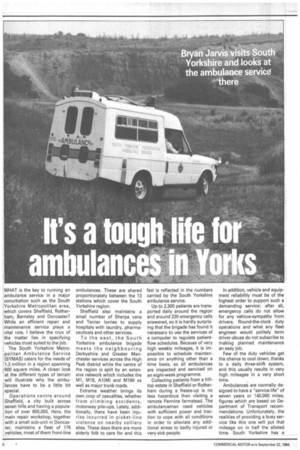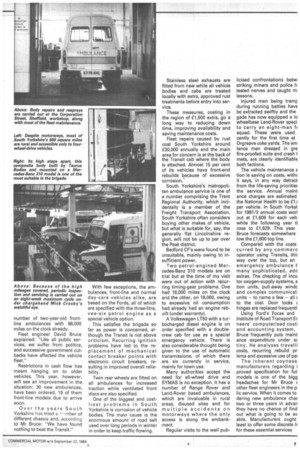WHAT is the key to running an ambulance service in
Page 42

Page 43

If you've noticed an error in this article please click here to report it so we can fix it.
a major conurbation such as the South Yorkshire Metropolitan area, which covers Sheffield, Rotherham, Barnsley and Doncaster? While an efficient repair and maintenance service plays a vital role, I believe the crux of the matter lies in specifying vehicles most suited to the job.
The South Yorkshire Metropolitan Ambulance Service (SYMAS) caters for the needs of 1.3 million in a region spanning 600 square miles. A closer look at the different types of terrain will illustrate why the ambulances have to be a little bit special.
Operations centre around Sheffield, a city built across seven hills and having a population of over 600,000. Here, the main repair workshop, together with a small sub-unit in Doncaster, maintains a fleet of 176 vehicles, most of them front-line ambulances. These are shared proportionately between the 13 stations which cover the South Yorkshire region.
Sheffield also maintains a small number of Sherpa vans and Terrier lorries to supply hospitals with laundry, pharmaceuticals and other services.
To the east, the South Yorkshire ambulance brigade meets the neighbouring Derbyshire and Greater Manchester services across the High Peak district while the centre of the region is split by an extensive network which includes the Ml, M18, A1(M) and M180 as well as major trunk roads.
Extreme weather brings its own crop of casualties, whether from climbing accidents, motorway pile-ups, Lately, additionally, there have been injuries incurred in picket-line violence on nearby colliery sites. These days there are more elderly folk to care for and this fact is reflected in the numbers carried by the South Yorkshire ambulance service.
Up to 2,300 patients are transported daily around the region and around 220 emergency calls answered, so it is hardly surprising that the brigade has found it necessary to use the services of a computer to regulate patientflow schedules. Because of very high weekly mileages, it is impossible to schedule maintenance on anything other than a time basis, so all ambulances are inspected and serviced on an eight-week programme. Collecting patients from a hilltop estate in Sheffield or Rotherham during a freeze-up is no less hazardous than visiting a remote Pennine farmstead. The ambulancemen need vehicles with sufficient power and traction to cope with all conditions in order to alleviate any additional stress to badly injured or very sick people. In addition, vehicle and equipment reliability must be of the highest order to support such a demanding service; after all, emergency calls do not allow for any vehicie-sympathy from drivers. Round-the-clock duty operations and what any fleet engineer would politely term driver-abuse do not subscribe to making planned maintenance an easy job.
Few of the duty vehicles get the chance to cool down, thanks to a daily three-shift system, and this usually results in very high mileages in a very short time.
Ambulances are normally designed to have a "service life" of seven years or 140,000 miles, figures which are based on Department of Transport recommendations. Unfortunately, the realities of providing a busy service like this one will put that mileage on in half the alloted time. South Yorkshire has a number of two-year-old frontline ambulances with 98,000 miles on the clock already.
Fleet engineer David Bruce explained: "Like all public services, we suffer from politics, and successive government cutbacks have affected the vehicle fleet."
Restrictions in cash flow has meant hanging on to older vehicles. This year, however, will see an improvement in the situation: 30 new ambulances, have been ordered, 19 of them front-line models due to arrive soon.
Over the years South Yorkshire h3s tried a --,r-nber of different chassis and, according to Mr Bruce: "We have found nothing to beat the Transit."
With few exceptions, the am bulances, front-line and normal day-care vehicles alike, are based on the Fords, all of which are specified with the three-litre, vee-six petrol engine as a special vehicle option.
This satisfies the brigade so far as power is concerned, although the Transit is not above criticism. Recurring ignition problems have led to the replacement of mechanical contact breaker points with electronic circuit breakers, resulting in improved overall reliability.
Twin rear wheels are fitted on all ambulances for increased traction while ventilated front discs are also specified.
One of the biggest and costliest problems in South Yorkshire is corrosion of vehicle bodies. The main cause is the enormous amount of road salt used over long periods in winter in order to keep traffic flowing. Stainless steel exhausts are fitted from new while all vehicle bodies and cabs are treated locally with extra, approved rust treatments before entry into service.
These measures, costing in the region of £1,500 extra, go a long way to reducing down time, improving availability and saving maintenance costs.
Fleet repairs caused by rust cost South Yorkshire around £30,000 annually and the main area for concern is at the back of the Transit cab where the body is attached. Almost 15 per cent of its vehicles have front-end rebuilds because of excessive corrosion.
South Yorkshire's metropolitan ambulance service is one of a number comprising the Trent Regional Authority, which incidentally is a member of the Freight Transport Association. South Yorkshire often considers buying other makes of vehicle, but what is suitable for, say, the generally flat Lincolnshire region, will not be up to par over the Peak district.
Bedford CF's were found to be unsuitable, mainly owing to insufficient power.
Two petrol-engined Mercedes-Benz 310 models are on trial but at the time of my visit were out of action with recurring timing-gear problems. One had 16,000 miles on the clock and the other, on 18,000, owing to excessive oil consumption had already had an engine rebuilt (under warranty).
A Volkswagen LT50 with a turbocharged diesel engine is on order specified with a doublecrew cab for use as a special emergency vehicle. There is also considerable thought being given to the use of automatic transmissions, of which there are six currently in service, mainly for town use.
Many authorities accept the need for all-wheel drive and SYMAS is no exception. It has a number of Range Rover and Land-Rover based ambulances, which are invaluable in rural areas, disused sites and for multiple accidents on motorways where the only access is along the embankment.
Regular visits to the well pub
licised confrontations betw striking miners and police h tested nerves and taught m lessons.
Injured men being tramp during running battles have be extracted swiftly and the gade has now equipped a lo wheelbase Land-Rover speci to carry an eight-man fi squad. These were used cently for the first time at Orgreave coke yards. The am lance men dressed in gre fire-proofed suits and crash I mets, are clearly identifiable both factions.
The vehicle maintenance s. tion is saving on costs, with it says, in any way detract from the life-saving prioritie$. the service. Annual maint ance charges are estimated the National Health to be £1,1 per vehicle. In South Yorks) for 1981/2 annual costs wori out at £1,609 for each veh while the following year tl rose to £1,629. This year Bruce forecasts somewhere low the £1,600 top line.
Compared with the costs curred by any commerc operator using Transits, thif. way over the top, but an emergency ambulance many sophisticated, adc extras. The checking of incu tor oxygen-supply systems, s tion units, pull-away windc and complex communicat units — to name a few — all z to the cost. Door locks hinges are replaced frequentl Using Ford's Focas and Institute of Road Transport Er neers' computerised cost] and accounting system, Bruce frequently puts maint ance expenditure under sc tiny. He analyses travelli costs, recurring rebuild pr lems and excessive use of pal
The inherent coyness manufacturers regarding i proved specification for fut models is one of the bigg headaches for Mr Bruce z. other fleet engineers in the p lic service. When it comes to dering new ambulance cha. two or three years in advar they have no chance of find out what is going to be av able. Manufacturers ought least to offer some discrete h for these essential services




























































































